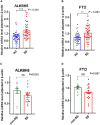The potential role of RNA N6-methyladenosine in primary Sjögren's syndrome
- PMID: 36465909
- PMCID: PMC9710536
- DOI: 10.3389/fmed.2022.959388
The potential role of RNA N6-methyladenosine in primary Sjögren's syndrome
Erratum in
-
Corrigendum: The potential role of RNA N6-methyladenosine in primary Sjögren's syndrome.Front Med (Lausanne). 2023 Jul 11;10:1251795. doi: 10.3389/fmed.2023.1251795. eCollection 2023. Front Med (Lausanne). 2023. PMID: 37497273 Free PMC article.
Abstract
Objective: The pathogenesis of primary Sjögren's syndrome (pSS) remains incompletely understood. The N6-methyladenosine (m6A) RNA modification, the most abundant internal transcript modification, has close associations with multiple diseases. This study aimed to investigate the role of m6A in patients with pSS.
Materials and methods: This study enrolled 44 patients with pSS, 50 age- and gender-matched healthy controls (HCs), and 11 age- and gender-matched patients with non-SS sicca. We detected the messenger RNA (mRNA) levels of m6A elements (including METTL3, WTAP, RBM15, ALKBH5, FTO, YTHDF1, YTHDF2, YTHDF3, YTHDC1, and YTHDC2), ISG15, and USP18 in peripheral blood mononuclear cells (PBMCs) from patients with pSS, patients with non-SS sicca, and HCs. The clinical characteristics and laboratory findings of patients with pSS and patients with non-SS sicca were also collected. We used binary logistic regression to determine if m6A elements were risk factors for pSS.
Results: The mRNA levels of m6A writers (METTL3 and RBM15), erasers (ALKBH5 and FTO), and readers (YTHDF1, YTHDF2, YTHDF3, YTHDC1, and YTHDC2) were all significantly higher in PBMCs from patients with pSS than in HCs. The mRNA levels of m6A writers (METTL3 and WTAP) and readers (YTHDF2, YTHDF3, and YTHDC2) were lower in PBMCs from patients with pSS compared to patients with non-SS sicca. The expression of METTL3, RBM15, FTO, YTHDF1, YTHDF2, YTHDC1, and YTHDC2 was positively correlated with the level of C-reactive protein (CRP) of patients with pSS. The mRNA level of YTHDF1 in PBMCs from patients with pSS was negatively correlated with the EULAR Sjögren's syndrome disease activity index (ESSDAI) score. In patients with pSS, FTO, YTHDC1, and YTHDC2 were also related to white blood cells (WBCs), neutrophils, lymphocytes, and monocytes. Increased mRNA level of ALKBH5 in PBMCs was a risk factor for pSS, as determined by binary logistic regression analysis. The mRNA level of ISG15 was positively correlated with that of FTO, YTHDF2, YTHDF3, and YTHDC2 in patients with pSS.
Conclusion: Compared with HCs, the expression of METTL3, RBM15, ALKBH5, FTO, YTHDF1, YTHDF2, YTHDF3, YTHDC1, and YTHDC2 was considerably higher in PBMCs from patients with pSS. In comparison with patients with non-SS sicca, the expression of METTL3, WTAP, YTHDF2, YTHDF3, and YTHDC2 was reduced in PBMCs from patients with pSS. The m6A elements correlating with clinical variables may indicate the disease activity and inflammation status of pSS. Elevated expression of ALKBH5 was a risk factor for pSS. The dynamic process of m6A modification is active in pSS. m6A elements (FTO, YTHDF2, YTHDF3, or YTHDC2) might target ISG15, stimulate the expression of ISG15, and activate the type I IFN signaling pathway, playing an active role in initiating the autoimmunity in pSS.
Keywords: ALKBH5; ISG15; METTL3; N6-methyladenosine; YTHDF readers; primary Sjögren’s syndrome.
Copyright © 2022 Xiao, Wu, Deng, Zhao, Peng, Zhou, Zhang, Zhao and Fei.
Conflict of interest statement
The authors declare that the research was conducted in the absence of any commercial or financial relationships that could be construed as a potential conflict of interest.
Figures






Similar articles
-
Association of N6-methyladenosine readers' genes variation and expression level with pulmonary tuberculosis.Front Public Health. 2022 Aug 22;10:925303. doi: 10.3389/fpubh.2022.925303. eCollection 2022. Front Public Health. 2022. PMID: 36072379 Free PMC article.
-
Characteristics of n6-methyladenosine (m6A) regulators and role of FTO/TNC in scleroderma.Gene. 2024 Feb 5;894:147989. doi: 10.1016/j.gene.2023.147989. Epub 2023 Nov 14. Gene. 2024. PMID: 37972699
-
Comprehensive analysis of m6A related gene mutation characteristics and prognosis in colorectal cancer.BMC Med Genomics. 2023 May 16;16(1):105. doi: 10.1186/s12920-023-01509-8. BMC Med Genomics. 2023. PMID: 37194014 Free PMC article.
-
The critical roles of m6A modification in metabolic abnormality and cardiovascular diseases.Genes Dis. 2020 Jul 31;8(6):746-758. doi: 10.1016/j.gendis.2020.07.011. eCollection 2021 Nov. Genes Dis. 2020. PMID: 34522705 Free PMC article. Review.
-
The potential role of RNA N6-methyladenosine in Cancer progression.Mol Cancer. 2020 May 12;19(1):88. doi: 10.1186/s12943-020-01204-7. Mol Cancer. 2020. PMID: 32398132 Free PMC article. Review.
Cited by
-
Clinical Characteristics of Distinct Subgroups of Patients with Primary Sjögren's Syndrome Classified by Serological Profiles: A Comparison Study.J Pers Med. 2024 Sep 12;14(9):967. doi: 10.3390/jpm14090967. J Pers Med. 2024. PMID: 39338221 Free PMC article.
-
Autoimmune disease: a view of epigenetics and therapeutic targeting.Front Immunol. 2024 Nov 13;15:1482728. doi: 10.3389/fimmu.2024.1482728. eCollection 2024. Front Immunol. 2024. PMID: 39606248 Free PMC article. Review.
-
Methylation of T and B Lymphocytes in Autoimmune Rheumatic Diseases.Clin Rev Allergy Immunol. 2024 Jun;66(3):401-422. doi: 10.1007/s12016-024-09003-4. Epub 2024 Aug 29. Clin Rev Allergy Immunol. 2024. PMID: 39207646 Review.
-
M6A methylation modification in autoimmune diseases, a promising treatment strategy based on epigenetics.Arthritis Res Ther. 2023 Oct 2;25(1):189. doi: 10.1186/s13075-023-03149-w. Arthritis Res Ther. 2023. PMID: 37784134 Free PMC article. Review.
-
RNA modification: a promising code to unravel the puzzle of autoimmune diseases and CD4+ T cell differentiation.Front Immunol. 2025 Mar 24;16:1563150. doi: 10.3389/fimmu.2025.1563150. eCollection 2025. Front Immunol. 2025. PMID: 40196109 Free PMC article. Review.
References
-
- Shiboski CH, Shiboski SC, Seror R, Criswell LA, Labetoulle M, Lietman TM, et al. 2016 American College of rheumatology/european league against rheumatism classification criteria for primary sjögren’s syndrome: a consensus and data-driven methodology involving three international patient cohorts. Arthritis Rheumatol. (2017) 69:35–45. - PMC - PubMed
LinkOut - more resources
Full Text Sources
Research Materials
Miscellaneous

